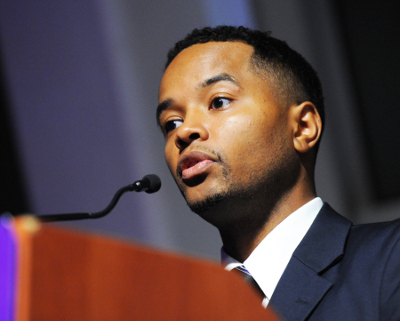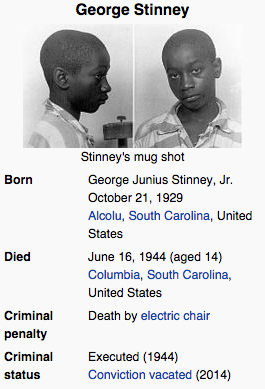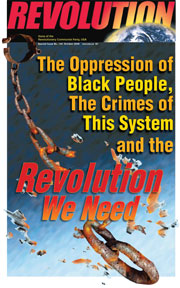The Criminalization of Black Children...And the Way Police are Allowed to Police
October 5, 2015 | Revolution Newspaper | revcom.us
The following is a rush transcript of a talk given by Angelo Pinto from the Raise the Age Campaign at the Night For Justice at NYU on October 1, 2014.

Angelo Pinto speaking at the Night for Justice. Photo: revcom.us/Revolution
I work for an organization called The Correctional Association of New York which is an organization that’s been around for about 170 years, a long time. And essentially what they started to do, or what they were charged with doing, was monitoring prison conditions in New York State. So for about a little less than 170 years they have been monitoring prison conditions in New York State, everything from solitary to what’s happening with women being shackled, etc. There’s a number of campaigns that speak specifically to the needs of individuals who find themselves incarcerated in New York State. One of them I mentioned is around solitary, there’s also some legislation around domestic violence survivors, and also there’s anti-shackling legislation because there’s a lot of women who give birth while incarcerated in New York State and many of them end up being shackled while giving birth, that’s still happening.
I work specifically on a campaign called Raise the Age. New York State is currently one of two states that automatically prosecutes 16 and 17 year olds as adults for any crime that they commit. I’m going to say that again if you didn’t get it: New York State is one of two states that automatically prosecutes 16 and 17 year olds as adults for any crime that they commit. North Carolina is the other. Thirteen, 14 and 15 year olds are also prosecuted as adults for certain crimes. And a child as young as seven can be arrested in New York State. About a year and a half ago there was a young man who was 5 years old in the Bronx who was handcuffed for stealing $5 from one of his classmates. So these are things that happen.
Just to give you some more context and numbers into the issue—in New York State, when you talk about the 16 and 17 year olds who are prosecuted as adults you’re talking about 33,000 16 and 17 year olds [2013 statistic]. So you’re not talking about any small number of young people. So about 33,000 young, 16 and 17 year olds are coming in contact with the criminal justice system and charged as adults.
What that means is that those same 16 and 17 year olds are automatically housed in adult jails and prisons. So if you’re 16 years old in New York City right now and you hop a turnstile and you’re arrested and you go through intake and you have to spend some days behind bars, you go to Rikers Island. And the Department of Justice did a report on Rikers Island about January of last year and they talk about Lord of the Flies-like conditions in Rikers Island. You have young people who have had broken bones, slashing in Rikers Island.
About a year I had the opportunity to visit a facility in the New York State Prison called Greene Correctional Facility about an hour north of Manhattan. And this is the facility where most 16 and 17 year olds who are charged as adults stay, the prison facility. The median age at Greene is about 23 years old. You have a tremendous amount of young people in Greene Correctional Facility. There’s a high school there for the 16 and 17 year olds, most of whom are still finishing school; there’s a high school in Rikers as well. And one of the first things you felt when I entered was fear. Most of the young people in the school wouldn’t look up from their desk. And it took us going into two different dormitories before any of the young people would really start talking to us. And what they started to say is that this is a hands on facility. And what we found out soon was that essentially for just about anything correction officers will put their hands on individuals, the youth would be severely beaten and tortured.
There is a report you should look at called, “Growing Up Locked Down” that looked at the use of solitary confinement on young people in the United States. It looked at New York State and one of the things it found was that young people who spend time in solitary confinement spend longer sentences in solitary confinement than adults. So upwards of 40 days is an average sentence for a teenager in solitary confinement in an adult prison in New York state, that’s the median length of time.
The United Nations Special Rapporteur has said that 15 days of solitary confinement is torture for anybody. For anybody. Any time in solitary confinement is torture for a child or a pregnant woman. So in the United States, and in New York State specifically, and every other state in the country, is engaging in torture of children. They are engaging in the torture of children. It’s important to start to look at these issues that kind of way.
When you see the death of a young person at the hands of a police officer, the people who are supposed to be protecting them—when you see a person in solitary confinement in a system that is supposed to make them better, you start to see that there’s something wrong here. And it’s important for us to use the language of exactly what is taking place.
One of the things that I think is important is understanding how we got here, right? So we’re at a moment in history where 16 and 17 year olds for a long time now in this state have been prosecuted as adults. And the question is how did we get here, how did we get to this place? We didn’t always start there. I want to give us a quick history lesson in juvenile justice or what I like to refer to as youth justice in the United States of America.

So is anyone familiar with a young man named George Stinney? George Stinney, you should know who he is. In 1944 George Stinney was a 14 year old boy who happened to be in the wrong place at the wrong time. In his community two young girls, two young white girls went missing. So a team assembled to look for these young white girls and George Stinney decided that he would participate, he would help. But in the course of his assisting a gentleman was talking to him and George said that he saw the girl earlier in the day.
To make a long story short, George, 14 years old at the time, was charged and accused of murder on these two girls. First of all there is no evidence of this. To make matters worse, George Stinney was convicted in a two hour trial of murder and not only was he convicted he was sentenced to death by electric chair. A 14 year old boy. So it’s the youngest recorded execution in United States history. A 14 year old African American boy. No evidence to suggest that he committed the crime whatsoever. George Stinney was about 5’ 1”, 98 pounds, he was so small they had to put about 4 textbooks on the chair for him to sit on to be executed. And it took several attempts because the device that they were using was too big for him.
So I’m trying to paint this picture of how we get to a place where we’re continuing to torture young people in the United States.
Fast forward, and look specifically at New York State. There’s a young man named Willie Bosket who in 1979 was a young man, a 15 year old who was charged with two murders on the 2-3 train in Harlem.
There’s a great book called All God’s Children”[by Fox Butterfield] which talks about Willie Bosket and the culture of violence that he inherited. Essentially what happened was Willie Bosket was given 5 years, he was 15 years old, that was the longest sentence you could give a juvenile for anything at the time. The state was outraged and as a result what happened was that 13, 14 and 15 were now prosecuted as adults. So Willie Bosket was a landmark case.
Willie Bosket’s story was so significant—there was a gentlemen who was covering the story for the New York Times named Fox Butterfield who said, “I want to figure out how you get a Willie Bosket,”— how do we get a young person who is committing these kinds of crimes. Willie Bosket at that time was being called the worst criminal in the history of New York State. They were calling him a baby faced monster and some of the worst things you can think of.
So Fox Butterfield did this expose and this research on Willie Bosket and what he found out was Willie Bosket’s father had committed murder. He dug a little deeper and realized that Willie Bosket’s father’s father had committed murder. He said, we have to go deeper and so he traces Willie Bosket’s lineage all the way back to a county in South Carolina called Edgefield. At this time in our history, South Carolina happened to be the most violent state in the country and Edgefield was the most violent county in South Carolina, where there was dueling. And there’s even court records with stories of people entering court who are missing eyes and missing teeth.
There was a culture of violence that was so pervasive. Willie Bosket’s ancestors were slaves in Edgefield. And in this book it traces a culture of violence that didn’t originate in South Carolina or didn’t start with Willie Bosket’s ancestors but went back to Irish Scots in Europe who actually enslaved Willie Bosket’s ancestors and were their overseers in South Carolina. And this book shows you how the culture of violence spread from folks who are enslaved in the South of the United States and eventually migrated north and were living in extremely impoverished conditions. And so I’m still trying to paint this picture.
Fast forward ten years and you have the Central Park 5—the five men from Harlem who are charged as adults in the Central Park Jogger Case. One of the biggest cases probably in the last 50 years. Some of you may know that Donald Trump took out a full page ad in the New York Times to have them executed.
Fast forward a little bit further and four months ago you have Kalief Browder, a 16 year old boy charged as an adult, spent three years on Rikers Island for stealing a book bag. They did not have enough evidence to prosecute him, he was released because he wouldn’t accept a plea bargain. Sometime, later, four months ago now, Kalief committed suicide. He spent time in solitary confinement, there’s video of him being beaten by correctional staff on Rikers Island.
Part of what I’m trying to show or illustrate is that there has been a process to get us to this place where we are with youth justice in the United States and in New York State. Part of that process has been the criminalization of Black children and this image of Black children as being criminals, as being monsters, as being super predators. When you connect and you start to look at policing you start to realize that this is the sentiment that allows police to police young Black people the way they do, certain communities to be policed the way they do.
A year ago I was in Geneva testifying about raising the age of criminal responsibility and the day I was there was the day Michael Brown was murdered, it was last August. And I remember folks were sitting around saying—Ferguson was pretty much exploding and we were in another country and we were saying, what does this mean for our issues?
We started a direct connection between the way that police are allowed to police and what was happening to young people. Michael Brown, Trayvon Martin—they could have been young people who had been moving through the criminal justice system like Kalief Browder. But because the police [and vigilante George Zimmerman] acted with force they ended up dead. And that is where we are at this historical moment. The question now is what? Because you have tremendous amounts of young people who are now returning to these communities who are displaced, who don’t have access to education, who have been tremendously traumatized. And this is kind of the kicker and I’ll close with this.
Khalil Gibran Muhammad at the Schomberg wrote a book called The Condemnation of Blackness and in this book he talks about how blackness has been criminalized in the United States. Michelle Alexander wrote the book called The New Jim Crow and she is saying how mass incarceration is the New Jim Crow. When you look at slavery, what ended slavery was the 13th Amendment . And the 13th Amendment clearly says either slavery or voluntary servitude except or by function of a crime. So essentially in the United States, if you are convicted of a crime you are still subject to what slaves were subject to in the United States. We still find ourselves in that place today.
I want to close with a quote by W.E.B. Du Bois who said, “Negroes who have been arrested, who are accused of crime, who have been convicted and incarcerated, every Negro knows that a frightful proportion of Negroes accused of a crime are absolutely innocent. Nothing in the world is easier in the United States than to accuse a Black man of a crime.”
Volunteers Needed... for revcom.us and Revolution
If you like this article, subscribe, donate to and sustain Revolution newspaper.







